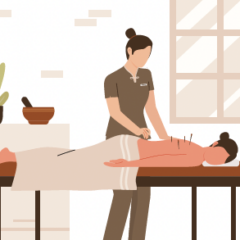Last updated on
I’ve been prescribed a blood thinner – now what?
What to Expect If You’ve Been Prescribed a Blood Thinner
An anticoagulant (often called a “blood thinner”) is a medication that’s used to treat and prevent blood clots. While they don’t actually thin the blood or break up existing clots, they do stop clots from getting bigger - and help prevent new (or recurrent) clots. Blood thinners are commonly used medicines, but there are several key things to be aware of if you take one.
Common Blood Thinner Side Effects
Blood thinners increase the time it takes for your blood to clot, which can result in bleeding. Common, bleeding-related side effects that you may experience while on a blood thinner include…
- Bruising easily or having larger bruises: Bruises are internal bleeds, so when you’re on a blood thinner, you may bruise more easily.
- Bleeding from minor cuts, nosebleeds, or brushing teeth: Since a blood thinner makes it harder for your blood to clot (which is how it prevents blood clots), you may find that little cuts or nosebleeds take longer to stop bleeding, and you may see more blood than usual.
- Heavy periods: Many women experience heavier periods (and fatigue during their periods) when on a blood thinner.
- Gum sensitivity: Blood thinners will often make your gums extra sensitive and prone to bleeding, especially when brushing or flossing teeth.
ALWAYS take your blood thinner as directed, and speak with your doctor if you’re experiencing severe or abnormal side effects.
Common Blood Thinner Interactions with Drugs and Foods
There are many drugs and foods that can interact with your blood thinner, either by making it too effective (increasing your risk of bleeding), or by preventing it from working effectively (putting you at risk for a clot). Common interactions with foods and drugs include:
- Turmeric contains an ingredient similar to one that’s found in warfarin, and can increase the risk of bleeding. Let your doctor know if you’re using turmeric regularly.
- Alcohol can increase the risk of bleeding and the likelihood of falling, which can be especially dangerous when on a blood thinner. Limiting alcohol intake is strongly recommended.
- Aspirin can increase the risk of bleeding and should be avoided. Instead use a pain reliever such as acetaminophen (like Tylenol), unless otherwise directed by your doctor.
- Cannabis or CBD products can increase the risk of bleeding. Let your doctor know if you’re using CBD or marijuana regularly.
- Fish oil can increase risk of bleeding when used in large quantities. Let your doctor know if you’re taking fish oil regularly.
- Garlic can prolong bleeding time and ideally should not be consumed within 7-10 days of a surgery. Let your doctor know if you eat garlic regularly.
- Ginkgo biloba can increase risk of bleeding. Let your doctor know if you use ginkgo biloba regularly.
- Grapeseed oil is a natural blood thinner. Consider using another type of oil instead, and let your doctor know if you use grapeseed oil regularly.
- Grapefruit is a consideration for patients on warfarin because it can increase the effect of warfarin and therefore increase the risk of bleeding. Let your doctor know if you eat or drink grapefruit regularly.
- St. John’s wort is a consideration for patients on warfarin because it can decrease the effectiveness of warfarin. Let your doctor know if you use St. John’s wort regularly.
- Vitamin K intake is a consideration for patients on warfarin because eating too much can increase risk of blood clots. Aim to eat about the same amount of Vitamin K each day.
Please tell your healthcare providers about all prescription or nonprescription medicines or supplements that you take—including over-the-counter medications, natural products, vitamins, and drugs—to avoid interactions. Remember: your doctor is there to help you, not judge you.
Blood Thinners & Lifestyle Considerations:
- Sports: You may be advised to avoid rough sports or high-contact activities (such as skiing, boxing, hockey, soccer, or wrestling). These sports put you at a high risk for bruising or internal bleeding, which can be dangerous when on a blood thinner.
- Sharp Objects: Be careful when using sharp objects, such as knives, razors, and even paper. Even a minor cut or scrape can take a while to stop bleeding when on a blood thinner.
- Falling: Take extra precautions to avoid falls, such as using handrails on stairs, wearing gripper socks, and watching your step. Major falls can result in bruising or internal bleeding, which can be dangerous when on a blood thinner.
Blood Thinners & Surgical Procedures:
- Dental cleanings and single extractions typically don’t require stopping blood thinners, though more invasive procedures such as dental surgery may require you to stop temporarily. Always contact your doctor for advice on what to do for these procedures.
- If you need surgery, it’s important to speak with both your surgical team and the clinician who prescribes your blood thinner before surgery. Many surgeries require patients to come off of their blood thinner before the surgery, so it’s important to discuss how to safely stop and start again.
What Else to Know:
Contact your doctor if you experience any of the following:
- Allergic reactions, like rashes, hives, itching, swelling of the mouth, face, lips, tongue, or throat, chest tightness, or trouble breathing
- Abnormal bleeding, such as large bruises, excessive bleeding from your gums or nose, any coughing up of blood, or any vomiting of blood
- Excessive bleeding during menstruation, or bloody urine or stools
- Dizziness, bad headaches, weakness on one side of body, or blurred eyesight
- Purple toes or feet, or any new pain in the legs, feet, or toes
Knowing when to stop a blood thinner
- Communicating with your doctor – many patients will be put on a blood thinner for 3-6 months. If you have not had a conversation with your doctor about when to stop your blood thinner and it has been 3-6 months since you were started taking your medication, please contact your care team.
- Coming off of a blood thinner – being on a blood thinner is an act of balancing the risk of forming a new clot versus the risk of bleeding. Finding the right balance is a personal experience; while some patients love being on a blood thinner because they feel protected, others feel that their quality of life is lower because of limitations (ie: avoiding skiing or certain pain medications). If you have questions about your blood thinner regimen, please speak with your doctor about the best blood thinner plan for you.
More Resources:
- NATF’s anticoagulation comparison chart – a printable chart that compares the major blood thinners in the US
- NATF’s deep dive articles into the different DOACs (Direct Oral AntiCoagulants) offered in the US – dabigatran (Pradaxa), rivaroxaban (Xarelto), apixaban (Eliquis), and edoxaban (Savaysa)
Recently Diagnosed?
Interested in learning more about diagnosis or joining a patient support group? Check out some of our resources!



